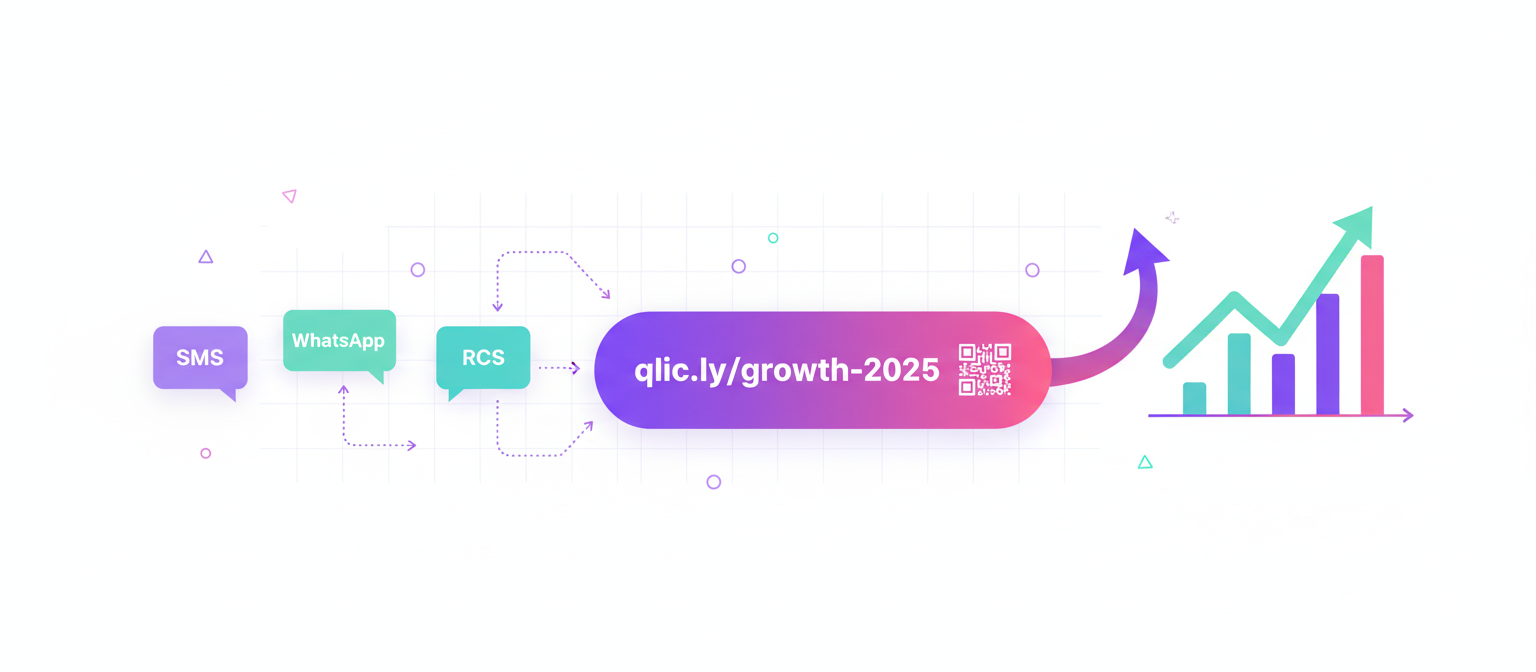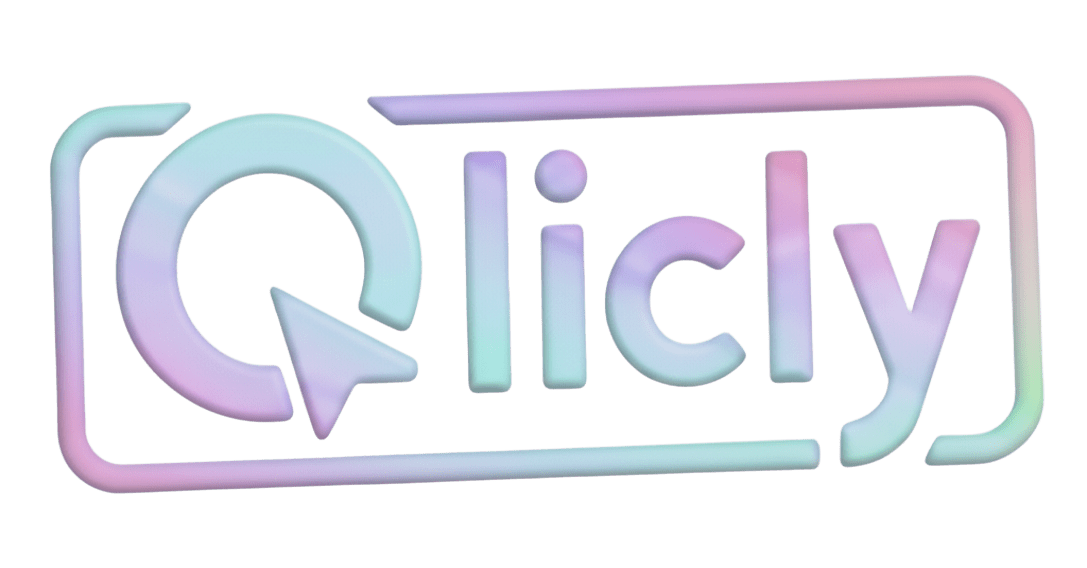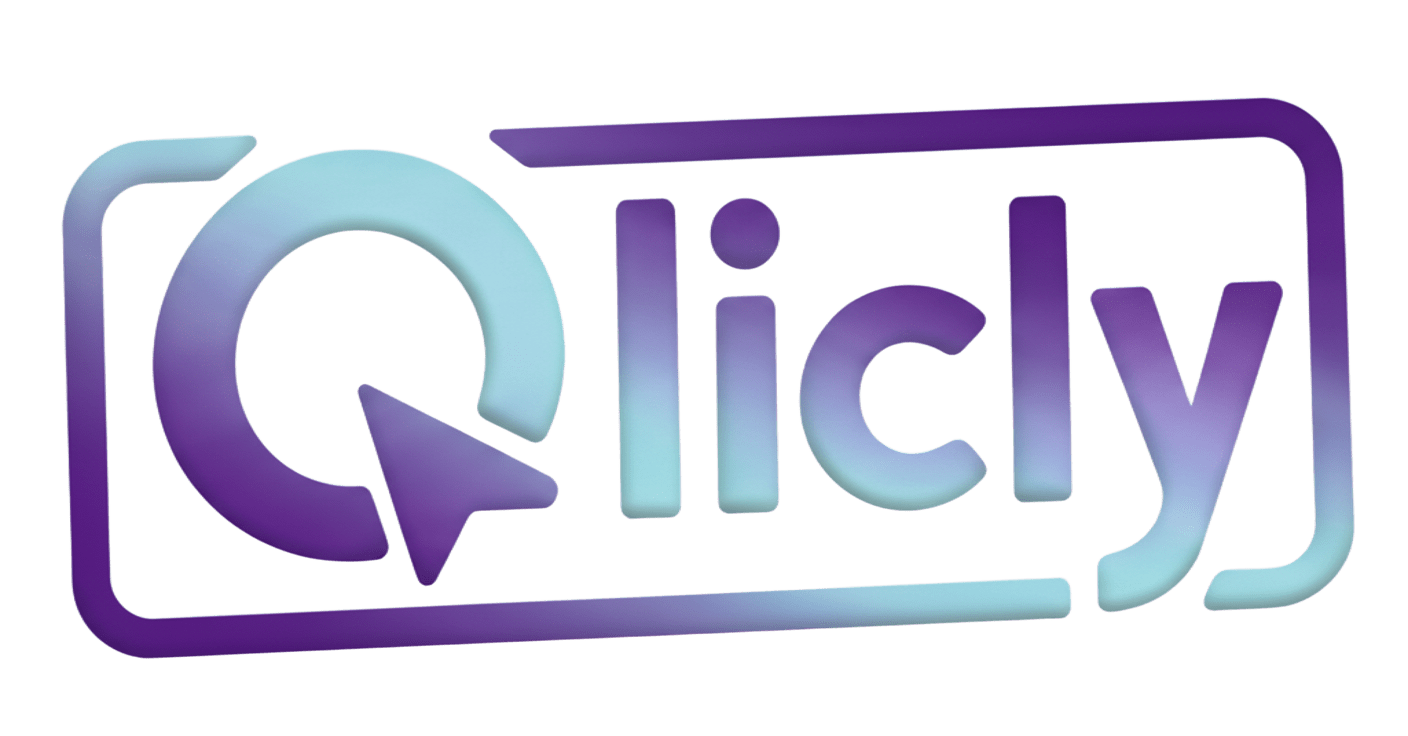
The fastest way to move someone from interest to action is still a message on their phone. In 2025, that message can land via three dominant channels: SMS, WhatsApp, and RCS (Rich Communication Services). Each has different reach, features, compliance risks, and analytics quirks. The common denominator that helps all three perform better is a branded short link—the kind you control on your own domain (e.g., qlic.ly/offer)—paired with clean GA4 UTM tagging.
This playbook compares SMS, WhatsApp, and RCS, then shows how to wire branded short links and UTMs to lift CTR, reduce “direct/none” in GA4, and harden security against URL-based threats and “quishing” (QR phishing). Real examples use qlic.ly and link back to the Qlicly ecosystem for implementation.
1) Channel snapshot: SMS vs WhatsApp vs RCS
SMS: unmatched ubiquity, basic features, dependable CTR
SMS remains the most universally reachable channel and a reliable way to trigger fast action. U.S. carriers report trillions of texts sent yearly—nearly 2.2 trillion texts in 2024 alone—underscoring SMS’s everyday habit strength. [3] CTR benchmarks vary by industry, but public roundups consistently place SMS CTR in the high single to double digits, surpassing many email and social formats in link engagement. [3]
WhatsApp: conversational UX with huge global reach
WhatsApp pairs interactivity (buttons, catalogs, templates) with massive adoption across key regions. It’s increasingly central to business messaging and customer support, and its monetization and policy changes keep expanding marketing possibilities (and obligations). Regulatory scrutiny and platform policy shifts make transparent links and accurate tagging vital. [3]
RCS: rich, app-like messaging from the default SMS inbox
RCS upgrades SMS with carousels, rich cards, verified sender profiles, and read receipts in the native Messages app—without requiring users to install a separate OTT app. Analysts forecast strong growth in RCS business messaging traffic in 2025, buoyed by ecosystem support and better interoperability. [4] Apple and Google have signaled support for secure RCS with end-to-end encryption advances, which raises consumer trust and opens richer brand experiences in default messaging. [5]
Bottom line: SMS offers reach, WhatsApp offers conversational depth, and RCS offers native, rich experiences. All three benefit when your links are short, on-brand, and well-tagged.
2) Why branded short links amplify performance (and trust)
Branded short links use your own domain (e.g., qlic.ly) rather than a generic domain. Across independent case studies and provider research, branded links have been shown to lift CTR—up to 39% vs. generic short URLs in experiments; and up to 34% CTR increase in aggregate analyses. [8][9] That lift comes from three psychological signals in the tiny space of a URL:
- Recognition: Your name appears in every link.
- Clarity: Human-readable slugs set expectations (e.g., qlic.ly/pricing).
- Safety: Recipients are likelier to trust recognizable domains in SMS/OTT messages.
In regulated or high-risk contexts (banking, government notices), the extra trust of a branded domain offsets skepticism that often suppresses clicks on unknown or generic shorteners.
Start with your highest-volume journeys and replace generic links with branded ones—then A/B test within the same creative. Use Qlicly’s Branded Domains to wire the domain and Qlicly Blog for best practices.
3) UTM hygiene: from “direct/none” to truthful attribution
GA4 will classify sessions as (direct)/(none) when campaign data is missing or stripped. Google is explicit: if links lack UTM parameters (or aren’t integrated correctly), traffic source information is lost. [1][2] Messaging links (SMS, WhatsApp, RCS) are especially prone to this because referrers are often absent; the only reliable signal is your UTM string. Use the canonical five:
utm_source = sms | whatsapp | rcs | partnerA utm_medium = owned | broadcast | conversation | cpc utm_campaign = launch_q4_2025 | renewal_push utm_content = button_primary | template_A | card_1 utm_term = (search ads only) Google’s URL builder guidance remains the source of truth. [1] Create your long URL with UTMs, then shorten it into a branded link (e.g., https://example.com/offer?utm_source=sms&utm_medium=owned&utm_campaign=fall_sale → qlic.ly/fall-sale). This keeps links elegant inside small chat bubbles while preserving analytics fidelity.
Fix the top five attribution leaks:
- Missing UTMs: mandate UTM templates for all messaging links. [1][2]
- Redirect chains: minimize hops; ensure UTMs persist through redirects. [2]
- Protocol issues: avoid HTTP→HTTPS hops that drop referrer data; standardize HTTPS. [2]
- PDFs & offline assets: always use UTM-tagged short links in downloadable collateral.
- Dark social re-shares: expect referrers to be absent; UTMs are your only source signal.
Example build:
- SMS offer: Long URL with UTMs → Shorten to qlic.ly/upgrade-sms and send: “Your 20% upgrade ends Friday: qlic.ly/upgrade-sms”.
- WhatsApp template: Use a Call-to-Action button with qlic.ly/wh-demo (UTMs behind it).
- RCS rich card: Primary button links to qlic.ly/rcs-try, preserving campaign metadata.
4) Security reality: URL-based threats & “quishing”
Attackers go where users click: malicious URLs now exceed attachments as the most common malware delivery vector. [7] At the same time, QR-based phishing (“quishing”) continues to surge, with security reports documenting millions of QR-linked threats across late 2024 and early 2025. [6]
Your trust stack for safer messaging links:
- Branded domain first: recipients can visually verify the domain (e.g., qlic.ly/billing-help), reducing suspicion. [8][9]
- Clear slugs: descriptive keywords (e.g., /support-ticket) that match message copy.
- Preview options: where supported, allow “expand”/preview before redirect.
- Monitoring: log link changes; keep redirect chains short and consistent.
- QR best practices: print the branded short link under the code (fallback + trust) and use dynamic destinations to revoke/rotate quickly if abuse occurs. [6]
Regulators and operators are also tightening anti-spam guidance around nuisance texts and suspicious messages; following best practices reduces brand and legal risk. [10]
5) Tactics: make each channel (and link) pull its weight
SMS playbook
- Keep it skimmable: 160 characters, one clear action, one link: qlic.ly/renew-now.
- Localize slugs: qlic.ly/mt-offer if targeting Malta; qlic.ly/uk-plan for UK segments.
- Time windows: send during local high-attention windows; respect quiet hours.
- Compliance: include opt-out language per region; maintain suppression lists. [10]
- A/B tests: generic vs branded link in identical copy to quantify CTR lift. [8][9]
WhatsApp playbook
- Template + button: pair approved templates with a CTA button to qlic.ly/wh-quote.
- Conversational routing: link to a short, on-brand URL that resolves per context (e.g., language or inventory) without changing the visible link.
- Commerce: use short links to deep-link into product detail, cart rescue, or account settings.
- Policy awareness: keep messages transactional or opted-in marketing per platform rules; log consent.
RCS playbook
- Rich cards + carousels: embed a single, branded CTA, e.g., qlic.ly/rcs-trial.
- Verified sender: align visual trust with link trust; keep the domain consistent.
- Audience availability: plan fallback to SMS where RCS is unsupported; use the same short link so analytics stay unified. [4][5]
6) Implementation in 7 steps
- Claim your branded domain (e.g., qlic.ly) and connect it in your link manager. See Qlicly Branded Domains.
- Define a UTM taxonomy for messaging channels (utm_source = sms/whatsapp/rcs; utm_medium = owned/broadcast/conversation). [1]
- Standardize slugs for clarity (/pricing, /demo, /renew), avoiding random strings.
- Build & shorten with a URL builder, then convert to a branded link (e.g., qlic.ly/renew). [1]
- Instrument security: scanning, alerting on unusual click patterns, and role-based access.
- Run controlled A/Bs: same copy, placement, audience; variable = link domain.
- Audit monthly: prune redirect chains, fix 404s, and rotate any compromised URLs.
7) Messaging patterns you can copy
Launch (SMS)
Copy: “New Pro plan saves 20%—ends Sunday. qlic.ly/pro-save”
Destination: https://example.com/pro?utm_source=sms&utm_medium=owned&utm_campaign=pro_launch_q4_2025&utm_content=cta_primary → Shortened to qlic.ly/pro-save.
Abandoned cart (WhatsApp)
Copy: “Your items are waiting. Finish checkout in 2 taps.” [Button → qlic.ly/finish-cart]
Destination: https://example.com/cart?utm_source=whatsapp&utm_medium=conversation&utm_campaign=cart_recovery&utm_content=template_A.
Trial signup (RCS)
Card title: “Start your 14-day trial” [Primary button → qlic.ly/rcs-trial]
Destination: https://example.com/trial?utm_source=rcs&utm_medium=broadcast&utm_campaign=trial_q4_2025&utm_content=card_primary.
8) Measurement: know what “good” looks like
- CTR uplift from branding: Track per-channel CTR before/after swapping generic links for qlic.ly/ links; expect a measurable lift based on published studies. [8][9]
- “Direct/none” shrink: After UTM standardization, (direct)/(none) should fall in GA4 traffic acquisition reports. [2]
- Security events: Monitor for spikes in clicks from unusual ASNs, geos, or devices; rotate links fast.
- RCS performance: Compare rich-card CTAs vs. plain SMS; attribute with consistent UTMs. [4]
9) Compliance & nuisance-message mitigation
Consumer protection regulators and operators are intensifying enforcement on spam texts, illegal promotions, and poor consent practices. Follow these ground rules:
- Consent & transparency: obtain opt-in appropriate to channel and region; reflect it in your templates and welcome flows.
- Sender identity: match display names and branded domains for easy recognition.
- Easy opt-out: standard keywords (e.g., “STOP”) and clear links to preferences.
- Security posture: educate customers to trust messages that display your brand and domain; warn about unknown QR codes. [10]
10) Frequently asked questions
Do branded short links help deliverability?
They help trust, which influences engagement and downstream filtering in some ecosystems. More importantly, branded links reduce user hesitation and support clear sender identity—both crucial in SMS and OTT chats. Studies show CTR gains (up to 39%/34%), and that engagement signal compounds across campaigns. [8][9]
Will RCS replace SMS?
RCS is growing quickly (traffic projected to surge in 2025), and encryption/interoperability announcements improve its outlook, but coverage is uneven by market. Keep SMS fallbacks and consistent linking (same short link, different creative). [4][5]
How do I reduce “direct/none” in GA4 from messaging?
Tag everything with UTMs and keep links consistent via a branded shortener. Google’s guidance is clear: missing UTMs = lost source data. [1][2]
What about QR codes in stores and print?
Use dynamic QR codes and print the branded link beneath (e.g., qlic.ly/sale-qr) so users can type if they’re wary. Monitor for abuse; rotate destinations fast if needed. [6][7]
11) Your 30-day rollout plan
- Week 1: connect a branded domain (e.g., qlic.ly), finalize UTM taxonomy, and build a link request form your team must use.
- Week 2: pilot an SMS campaign with an A/B of generic vs branded links (same copy, same segment).
- Week 3: ship a WhatsApp template and one RCS rich-card test, each using one descriptive slug.
- Week 4: audit GA4 for drops in (direct)/(none), prune redirect chains, and harden link security.
When you’re ready, explore more on the Qlicly Blog and set up branded domains to make every message look, feel, and measure like your brand.
References
- Google Analytics Help. (n.d.). [GA4] URL builders: Collect campaign data with custom URLs. https://support.google.com/analytics/answer/10917952?hl=en.
- Google Analytics Help. (n.d.). [GA4] Understand (direct)/(none) traffic. https://support.google.com/analytics/answer/15258820?hl=en.
- CTIA. (2025, Sept.). Americans Use Record 132 Trillion MBs; Talking and Texting on the Rise. https://www.ctia.org/news/americans-use-record-132-trillion-mbs-of-wireless-data-in-2024-ctia-annual-survey-finds.
- Juniper Research. (2025). RCS Business Messaging traffic to grow 50% in 2025. https://www.juniperresearch.com/press/rcs-business-messaging-traffic-to-grow-50-in-2025/.
- The Verge. (2025). Apple will soon support encrypted RCS messaging with Android users. https://www.theverge.com/news/629620/apple-iphone-e2ee-encryption-rcs-messaging-android.
- APWG. (2025). Phishing Activity Trends Report, Q1 2025. https://docs.apwg.org/reports/apwg_trends_report_q1_2025.pdf.
- ITPro. (2025). Malicious URLs overtake email attachments as the biggest malware threat. https://www.itpro.com/security/cyber-attacks/malicious-urls-overtake-email-attachments-as-the-biggest-malware-threat.
- Rebrandly Support. (2024). Generic Short URLs vs Branded Links: Which Has Better CTR? https://support.rebrandly.com/hc/en-us/articles/115007615288-Generic-Short-URLs-vs-Branded-Links-Which-Has-Better-CTR.
- Bitly. (2015). Branded Short Domains Case Study. https://docrdsfx76ssb.cloudfront.net/wp-content/uploads/2015/07/BitlyCaseStudy_BSD.pdf.
- Ofcom. (2025). Tackling nuisance calls and messages (updated July 25, 2025). https://www.ofcom.org.uk/phones-and-broadband/unwanted-calls-and-messages/tackling-nuisance-calls-messages.

